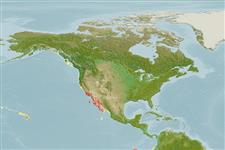Environment: milieu / climate zone / depth range / distribution range
Ecologie
marien demersaal; standvastig; diepte 1 - 21 m (Ref. 2850), usually ? - 10 m (Ref. 56052). Subtropical
Eastern Central Pacific: southern California, USA to Puerto Marquez, Mexico, including the Gulf of California.
Grootte / Gewicht / Leeftijd
Maturity: Lm ? range ? - ? cm
Max length : 13.0 cm TL mannelijk / geslacht onbekend; (Ref. 2850); max. gerapporteerde leeftijd: 6 Jaren (Ref. 56052)
Adults are found in rocky areas (Ref. 37955), inhabiting holes and crevices, often in burrows of boring clams or tubes of marine worms, also in mussel beds (Ref. 2850). Mostly sedentary and territorial (Ref. 2850). Demersal spawners in nearshore habitats (Ref. 56049). Oviparous. Eggs are demersal and adhesive (Ref. 205), and are attached to the substrate via a filamentous, adhesive pad or pedestal (Ref. 94114). Larvae are planktonic, often found in shallow, coastal waters (Ref. 94114).
Oviparous, distinct pairing (Ref. 205).
Eschmeyer, W.N., E.S. Herald and H. Hammann, 1983. A field guide to Pacific coast fishes of North America. Boston (MA, USA): Houghton Mifflin Company. xii+336 p. (Ref. 2850)
Status op de Rode Lijst van het IUCN (Ref. 130435)
Gevaar voor de mens
Harmless
Gebruik door de mens
Tools
Speciale rapporten
Download XML
Internetbronnen
Estimates based on models
Preferred temperature (Ref.
123201): 14.9 - 24.3, mean 22.3 °C (based on 117 cells).
Fylogenetische diversiteitsindex (Ref.
82804): PD
50 = 0.5000 [Uniqueness, from 0.5 = low to 2.0 = high].
Bayesian length-weight: a=0.01000 (0.00244 - 0.04107), b=3.04 (2.81 - 3.27), in cm total length, based on all LWR estimates for this body shape (Ref.
93245).
Trofisch niveau (Ref.
69278): 2.8 ±0.2 se; based on size and trophs of closest relatives
Weerstandsvermogen (Ref.
120179): Gemiddeld, minimale populatieverdubbelingstijd 1,4-4,4 jaar (tmax=5.5; Fec = 1,540).
Fishing Vulnerability (Ref.
59153): Low vulnerability (10 of 100).
